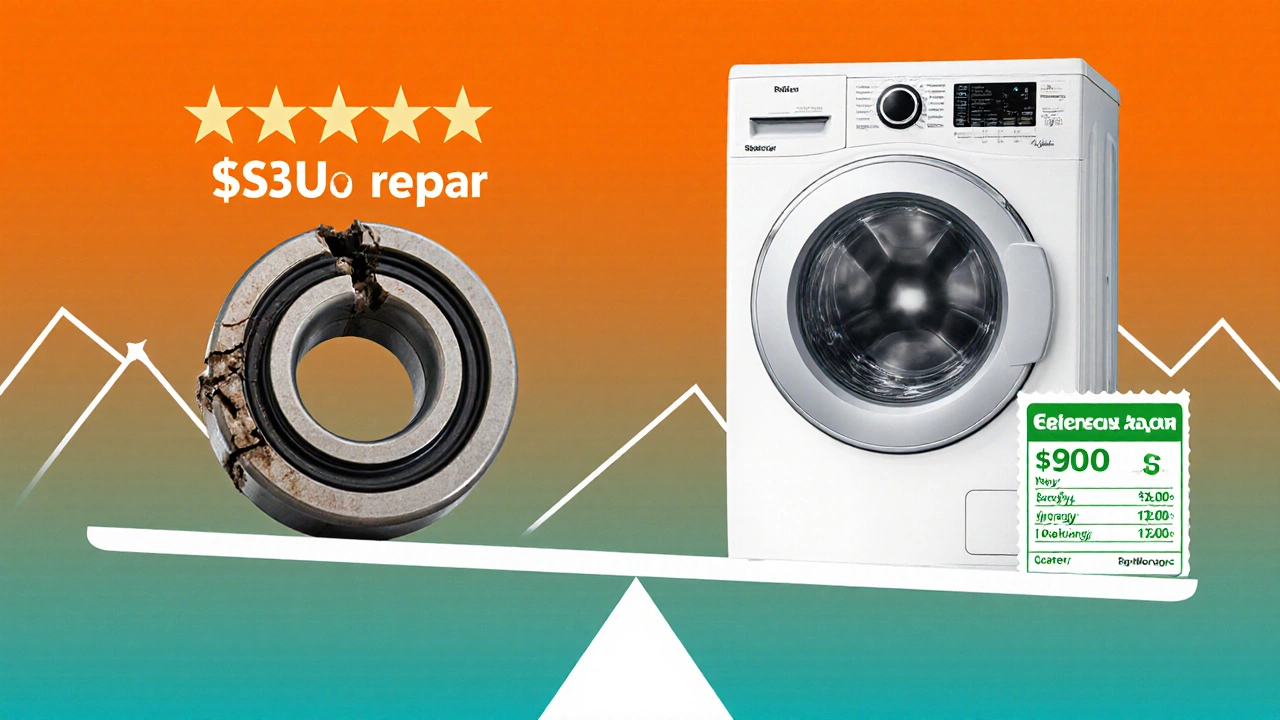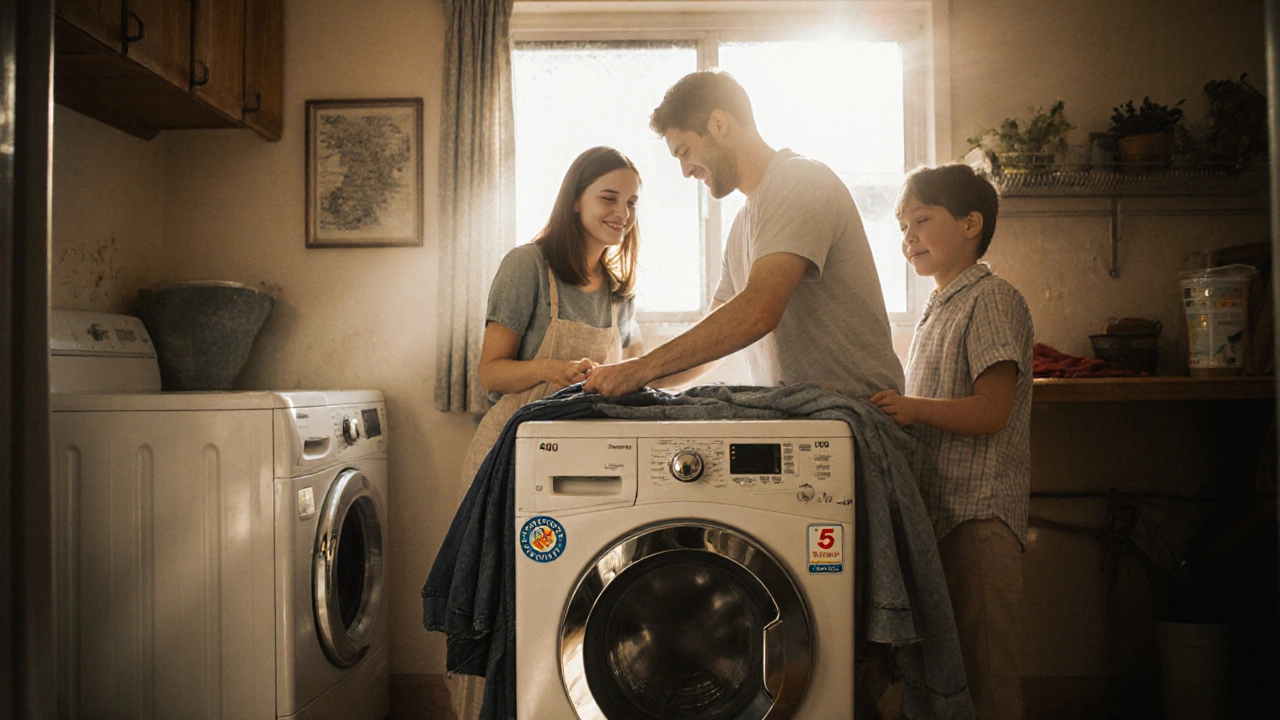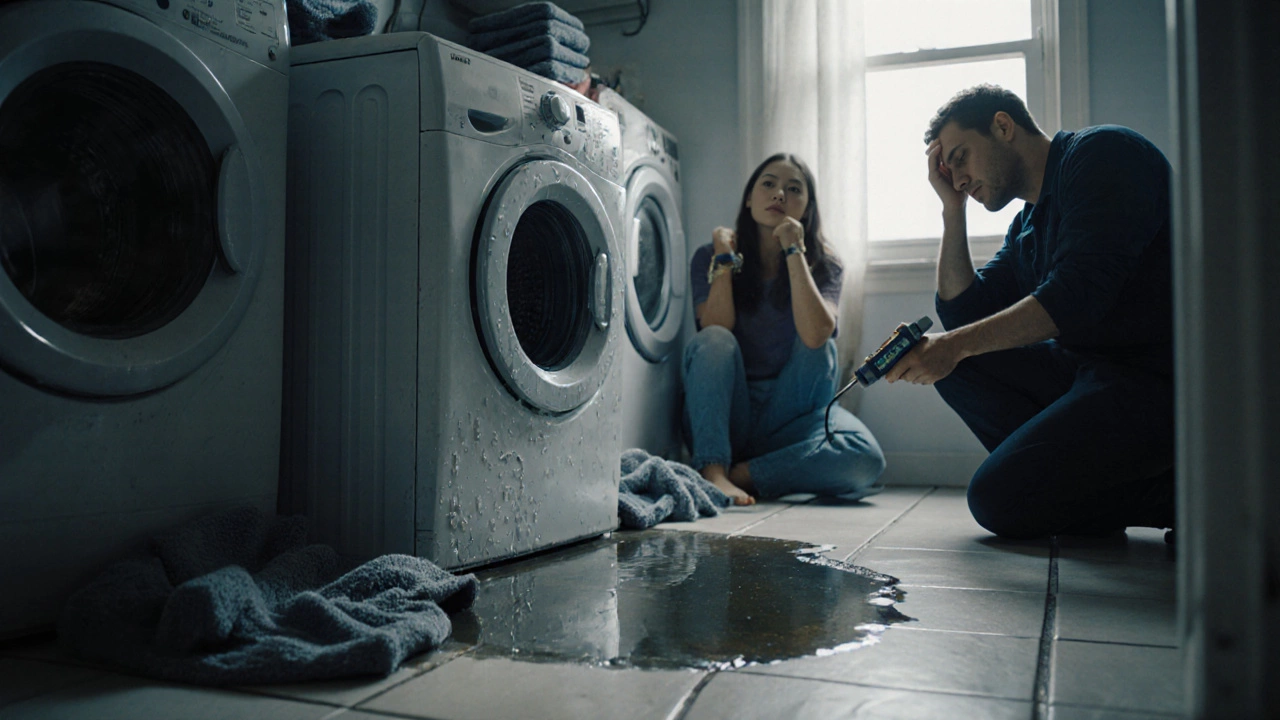Washing Machine Repair vs. Replace Calculator
Calculate Your Repair vs. Replacement Decision
Every time your washing machine makes that loud clunk or leaks water all over the floor, you ask yourself: washing machine repair or just buy new? It’s not just about money-it’s about time, stress, and how much life is left in the machine you’ve been using for years. In Auckland, where water bills are rising and appliance prices keep climbing, making the right call matters more than ever.
How old is your washing machine?
The age of your washing machine is the first real clue. Most machines last between 10 and 12 years with normal use. If yours is 8 years old or younger and it’s just having a minor hiccup-like a faulty door lock or a noisy spin cycle-it’s almost always worth fixing. But if it’s 12 years or older, and you’re facing a major repair like a drum bearing failure or a broken motor, you’re flirting with the edge of its lifespan. Replacing parts on a machine that’s already halfway through its life is like putting new tires on a car with a failing engine. You’ll pay now, and likely pay again soon.
A 2024 study by Consumer NZ found that machines older than 10 years are 3.5 times more likely to need a second repair within 12 months. That’s not luck-it’s physics. Rubber seals dry out, plastic gears crack under pressure, and motors wear down. The parts aren’t designed to last forever. If your machine is hitting double digits, treat every repair as a temporary fix, not a long-term solution.
What’s the repair actually costing?
Let’s say your machine won’t drain. You call a technician. The quote: $220 for the pump replacement, plus $90 for the service call. That’s $310 total. Sounds reasonable, right? But here’s the catch: the pump alone costs $85 online. Labor makes up nearly 75% of the bill. And if the pump fails because the drain hose is clogged with lint, you didn’t fix the root problem-you just replaced a symptom.
Compare that to a new mid-range washing machine in New Zealand: $800 to $1,200. You’re spending nearly a third of the price of a new machine on a single repair. Is it worth it? Only if that repair gives you another 5+ years of trouble-free use. But here’s what most people don’t realize: a $300 repair on a 10-year-old machine is like spending $1,500 on a 15-year-old car. You’re not investing-you’re delaying the inevitable.
What kind of repair are we talking about?
Not all repairs are created equal. Some are quick wins. Others are red flags.
- Easy fixes (worth repairing): Door latch, drain hose, water inlet valve, control panel buttons. These parts are cheap ($20-$70) and easy to replace. If your machine is under 8 years old, fix these without hesitation.
- Medium repairs (consider carefully): Drum bearings, drive belt, motor coupler. These cost $150-$350 to fix. If the machine is 6-9 years old, weigh it against a new model’s warranty and energy savings.
- Major repairs (walk away): Motor replacement, control board failure, drum crack. These cost $400-$700. At that point, you’re paying more than half the price of a new machine. Unless it’s a high-end brand like Miele or Bosch with a 10-year warranty, it’s time to replace.
One Auckland homeowner replaced the motor on her 11-year-old Samsung last year. Six months later, the control board died. She spent $650 total and ended up buying a new machine anyway. That’s not a repair-it’s a money trap.

Energy and water savings add up
New washing machines are far more efficient. A 2025 Energy Rating label shows that a 5-star rated machine uses 40% less water and 35% less electricity than a 10-year-old model. In Auckland, where water is getting pricier and power bills keep rising, that’s real cash in your pocket.
Let’s say your old machine uses 90 liters of water per load. A new one uses 55. That’s 35 liters saved per wash. If you do 20 loads a month, you’re saving 700 liters a month. Over a year, that’s over 8,400 liters-enough to fill a small swimming pool. Multiply that by $2.50 per 1,000 liters (Auckland’s average water rate), and you’re saving $21 a year just on water. Add electricity savings, and you’re looking at $120-$180 saved annually.
Over five years, that’s $600-$900 in savings. That’s almost the price of a new machine. So when you factor in running costs, the math flips: a $900 new machine pays for itself in 3-4 years.
Warranty and peace of mind
A new washing machine comes with at least a 2-year warranty. Many brands offer 5-year coverage on the motor. That means if something breaks, you don’t pay. You just call them. No labor fees. No hidden charges. Just a technician showing up.
When you repair an old machine, you get a 30-day guarantee on the part. That’s it. If the same part fails again, you pay again. If something else breaks next month? You’re back to square one. No protection. No peace of mind.
For families with kids, pets, or busy schedules, that peace of mind is worth more than most people realize. You don’t want to be stuck doing laundry by hand because your machine died on a Sunday night.

What about second-hand or refurbished?
Buying a used washing machine from a private seller? Risky. You don’t know its history. Was it used in a laundromat? Did it get overloaded? Was it left wet inside for months? Mold and rust build up fast.
Refurbished machines from certified retailers are better. Brands like Appliance Exchange and Trade Me Certified offer machines with 12-month warranties and full service checks. Prices range from $400-$700. That’s cheaper than a major repair, and you get a warranty. It’s a smart middle ground if you’re on a tight budget.
When to walk away
Here’s the simple rule: if the repair costs more than 50% of the price of a new machine, and your current machine is older than 8 years, walk away.
That’s not a suggestion. It’s a rule based on real-world data from appliance repair shops across Auckland. Most technicians will tell you this-if you ask them honestly. They don’t make money off you replacing machines. But they do make money off you thinking you’re saving money by repairing.
And if your machine is making grinding noises, leaking from the bottom, or taking 3 hours to do a simple load? Those aren’t signs of wear. They’re signs of failure. Don’t wait for it to flood your laundry room.
What to do next
First, check the age of your machine. Look for the serial plate-usually inside the door or on the back. The date is often stamped there.
Second, get a written quote for the repair. Ask: “Is this part a common failure on this model?” If they say yes, that’s a red flag.
Third, check what’s on the market. Look at energy ratings. Look at warranty length. Look at customer reviews. You’ll find that even the cheapest new machines today are quieter, faster, and more reliable than your 10-year-old one.
Finally, don’t let guilt hold you back. You didn’t buy this machine to suffer through breakdowns. You bought it to make your life easier. If it’s no longer doing that, it’s time to let it go.
Is it cheaper to repair or replace a washing machine?
It depends. If the repair costs less than half the price of a new machine and your washer is under 8 years old, repair it. If it’s older than 8 years and the repair costs more than $300, replacement is almost always the better financial choice. Factor in energy savings, warranty, and future repairs-those add up fast.
How long should a washing machine last?
Most washing machines last 10 to 12 years with normal use. Heavy use, hard water, or poor maintenance can cut that to 6-8 years. High-end brands like Miele or Bosch can last 15+ years, but they cost more upfront. Don’t expect a $600 machine to last 15 years-it’s not built for that.
What’s the most common washing machine repair?
The most common repair is a blocked or failed drain pump. Other frequent issues include worn drum bearings, broken door locks, and faulty water inlet valves. These are usually fixable if the machine is under 8 years old. Motor and control board failures are rarer but much more expensive.
Should I repair a washing machine that’s leaking?
It depends on where it’s leaking. A small leak from the door seal? Easy fix-replace the gasket for under $50. A leak from the bottom of the drum? That’s often a cracked tub or failed bearing. That repair costs $400-$600. At that point, replacement is smarter. Leaks from the base usually mean the machine is failing from the inside out.
Are refurbished washing machines worth it?
Yes-if they come with a warranty and have been professionally serviced. Refurbished machines from trusted sellers are tested, cleaned, and have worn parts replaced. They often cost 40-60% less than new and come with 12-month coverage. Avoid private sales unless you can test it fully and know its history.


